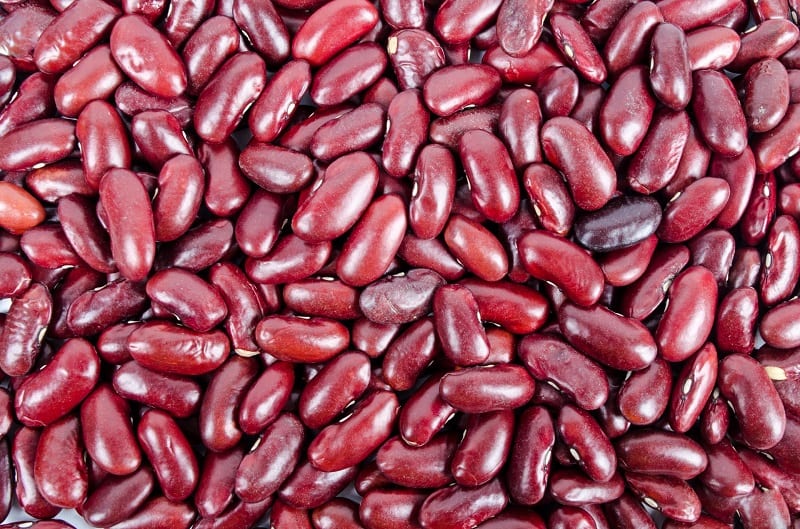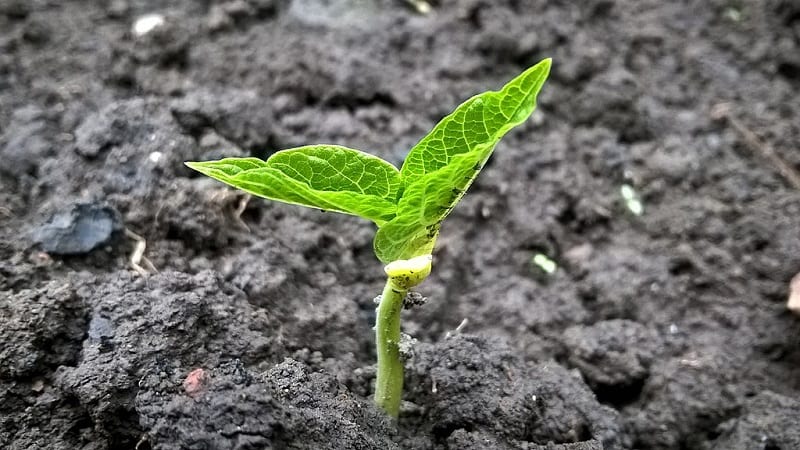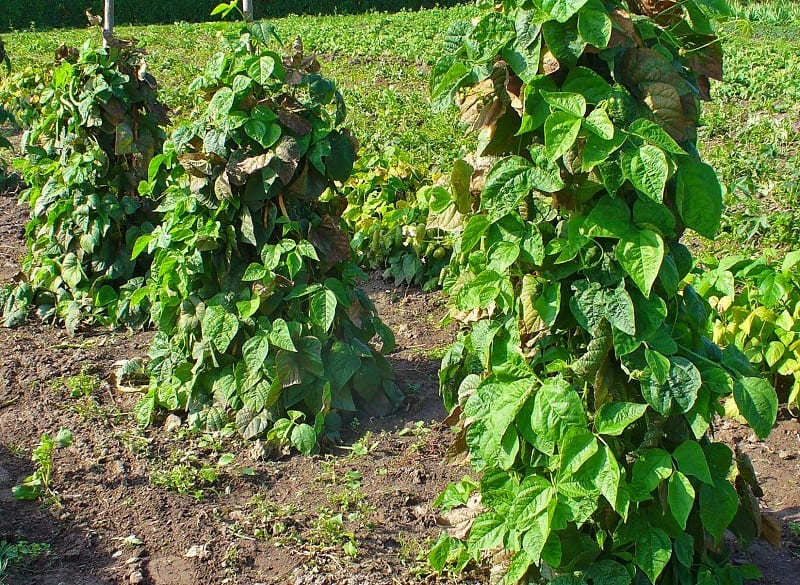Last Updated on January 24, 2025 by teamobn

(Photo: Marco Verch/Flickr)
Red beans, also called kidney beans, are both a healthy inclusion to your diet and an excellent crop for the home garden. High in proteins, they have antioxidant properties, vitamin B6, folic acid, and magnesium. They are also a rich source of cholesterol-lowering fiber.
Red beans are an essential pantry mainstay and a staple in vegetarian fare. Medical professionals and nutritionists recommend healthy servings for people with diabetes, hypoglycemia, or insulin resistance. The fiber in the beans keeps sugar levels in the human body from rising too rapidly.
Kidney Beans Growing Guidelines
Contents
Beans, in general, do not respond well to transplanting. That’s why experienced gardeners suggest sowing red kidney beans directly on the ground just after the last spring frost.
The plants require a long growing season, spanning about 80 days. But both the bush and vine varieties will rot in cool, damp soil. If you want an early start, put down black plastic in your garden to warm the soil.
Here’s how to grow red kidney beans from seed in your garden.

Planting Red Bean Seeds
Plant red beans eye side down in full sun, one to 1 ½ inches deep in moderately fertile, well-draining soil. Space seeds for vining varieties about 4 inches apart. Plant seeds for bush varieties 8 inches apart. The vining varieties will need some kind of support or trellis for climbing.
Water the seeds immediately. Keep in mind that bean plants should be well-ventilated to promote proper development. Good ventilation likewise deters mildew or mold, which are likely to trouble plants that grow without proper air circulation. You should not grow beans in the same spot more than once every four years.

Caring for Red Bean Plants
Red bean seedlings should emerge within 10 to 14 days of sowing. Pole beans may require some initial help climbing. Other than that, the plants will require minimal care. They produce their own nitrogen so you will have no need to apply fertilizer.
However, if you think some fertilizer is necessary, be sure not to use a product that is high in nitrogen. Such fertilizers will only stimulate lush foliage, not bean production.

(Photo: Mirishfaqhussain/Wikimedia Commons)
Keep the area around the plants free of weeds. Water the plants regularly, but when watering, try to avoid wetting the leaves. Wet leaves are likely to encourage unwanted fungus growth.
Most types of beans are fairly drought resistant, but check the surface of the soil frequently. Keep the soil moist but not soggy. A good layer of mulch will deter weeds and help maintain soil moisture.

Harvesting Red Beans
Red beans should be ready for harvest within 100 to 140 days of planting. Stop watering the plants when the pods start to dry out and yellow.
If the air is not too humid and you’ve allowed ample space between plants, the beans may well dry on the vine or bush. They will be hard as rocks and desiccated.
Otherwise, remove the entire plant from the soil when the pods turn the color of straw. Hang the plants’ upside down in a dry place to allow the beans to dry.
Once the beans are completely dry and cured, you can keep them in a tightly sealed container for about a year.
Soil Preparation for Kidney Bean Growing
Growing red kidney beans starts with proper soil preparation. These beans thrive in well-prepared soil, leading to a bountiful harvest. Here’s how to prepare your garden for planting.
Test the Soil
Testing the soil is a crucial first step in preparing to plant red kidney beans. These beans flourish in soil with a pH level that strikes the right balance between acidity and alkalinity, ideally between 6.0 and 7.0. This pH range supports optimal nutrient uptake and growth.
First, use a soil test kit or pH meter available at most garden centers or online. These tools provide accurate readings of your soil’s current pH level. If the pH below 6.0 indicates too much acidity, you can amend the soil by adding garden lime. Lime contains calcium carbonate, neutralizing acid, raising the soil’s pH to a more bean-friendly level.
Conversely, if your soil’s pH exceeds 7.0, showing it’s too alkaline, you can lower it by incorporating elemental sulfur into the soil. Sulfur reacts with the soil to form sulfuric acid, reducing the pH to suit red kidney beans better.
It’s essential to follow the instructions on the lime or sulfur packaging for the correct application rates, as these depend on your soil’s current pH and the size of the area you’re amending. After applying lime or sulfur, mix it thoroughly into the soil, then water the area to help the amendments start working. It might take a few weeks for the soil’s pH to adjust, so plan to test your soil and amend it well before your intended planting date.
Enhance Soil Quality
Enhancing soil quality is key to successful red kidney bean cultivation. These beans thrive in soil that is not only rich in nutrients but also maintains proper moisture without becoming waterlogged. To achieve this, incorporating organic matter into your garden bed is essential.
Start by adding compost or aged manure to your soil. Compost, made from decomposed organic materials, introduces a wealth of nutrients and beneficial microorganisms into the soil.
These elements are crucial for red kidney bean plants, providing them with the sustenance they need throughout their growth cycle. Aged manure, another excellent source of nutrients, also improves soil structure, enhancing its ability to retain moisture and air, both vital for root development.
The amount of organic matter you should add depends on your soil’s condition. A general guideline is to mix in a 2 to 4-inch layer of organic material into the top 6 to 8 inches of soil. This can be done with a shovel or tiller, ensuring the organic matter is evenly distributed throughout the planting area.
Additionally, consider incorporating a balanced, slow-release fertilizer into the soil at this stage. Choose a product with equal nitrogen, phosphorus, and potassium (NPK). This will provide a steady supply of essential nutrients to the red kidney beans as they grow.
Ensure Proper Drainage
Ensuring proper drainage is vital for the health and productivity of red kidney beans. These plants are particularly sensitive to waterlogged conditions, which can lead to root rot and other fungal diseases. Therefore, creating an environment where excess water can easily escape is essential to avoid these issues.
If your garden is prone to heavy, compact soil, like clay, there are effective ways to enhance drainage. One effective strategy is to raise your garden beds.
Raised beds allow you to control the soil mixture and structure, making achieving the well-draining conditions red kidney beans need easier. Elevating the planting area also improves air circulation around the plants, further reducing the risk of moisture-related diseases.
Another method to improve drainage in areas with heavy soil is by amending the soil with sand and organic matter. Sand increases the soil’s porosity, allowing water to flow more easily.
However, adding sand alone can sometimes lead to soil compaction, so combining it with organic matter like compost or aged manure is crucial. Organic matter not only enhances soil structure and drainage but also adds nutrients that support the growth of red kidney beans.
When preparing your garden for planting, work the sand and organic matter deeply into the soil, at least a foot deep, to ensure water can drain away from the bean roots effectively. This preparation helps prevent the roots from sitting in water, which is detrimental to the plant’s health.
Watering Techniques for Optimal Growth
Watering red kidney beans correctly is essential for their optimal growth. These plants need a steady moisture supply, but avoiding over-watering is crucial. Here’s how to water your red kidney beans for the best results.
Understand Watering Needs
Red kidney beans require consistent moisture, especially during flowering and pod formation. These beans thrive with a consistent supply of moisture, particularly during critical growth phases such as flowering and pod formation. At these stages, water plays a key role in the development of the beans inside the pods, impacting both the quantity and quality of your harvest.
However, balancing this moisture requirement with the risk of overwatering is important. Red kidney beans are sensitive to waterlogged conditions, which can lead to root rot and other plant diseases. The aim is to maintain soil moisture at a level that keeps the soil damp to the touch, but not waterlogged.
A good rule of thumb is to water the plants deeply once a week, allowing the water to penetrate the soil to a depth of several inches. This encourages deep root growth, which is beneficial for the plants.
The exact watering frequency might need to be adjusted based on local weather conditions and soil type. During high heat or windy conditions, evaporation rates increase, and the soil may dry out more quickly, necessitating more frequent watering. Conversely, during cool, cloudy periods, the soil retains moisture longer, and you may need to reduce the watering frequency to prevent over-saturation.
Observe the soil moisture near your plants to determine when it’s time to water. If the top inch of soil feels dry to the touch, it’s a good indication that it’s time to water. On the other hand, if the soil still feels moist, it’s best to wait and check again in a day or two.
This approach helps ensure that you provide your red kidney beans with the right amount of water at the right time, promoting healthy growth without the risk of water stress or disease.
Use the Right Watering Technique
Selecting the correct watering technique is pivotal for the health of red kidney beans. Direct water application to the soil instead of overhead watering minimizes the risk of leaf diseases such as fungal infections, which are more common when the foliage remains wet for extended periods. Watering at the base of the plant ensures that moisture reaches the roots directly, where it’s most needed for growth.
Drip irrigation systems and soaker hoses are particularly effective for this task. They slowly release water near the base of the plants, promoting deep water penetration into the soil.
This method reduces water wastage through runoff and evaporation, ensuring that your red kidney beans receive a steady and adequate moisture supply. Furthermore, by delivering water directly to the soil, these systems help maintain optimal humidity levels around the plants, supporting healthy growth without encouraging disease.
Monitor Soil Moisture
Monitoring soil moisture is a simple yet essential practice for watering red kidney beans efficiently. Regular checks help you water your plants according to their actual needs rather than on a fixed schedule. This approach is particularly useful in preventing over-watering and under-watering, both of which can adversely affect plant health and yield.
The finger test is a reliable method to assess soil moisture. Inserting your finger into the soil up to the second knuckle gives you a tangible sense of the soil’s moisture content at the root level. If the soil feels dry at this depth, it indicates that the plants need water. However, if you detect moisture, it’s advisable to delay watering for a day or two to avoid excessive moisture, which can lead to root rot and other issues.
Mulch to Retain Moisture
Applying a layer of mulch around your red kidney beans is a highly effective strategy for retaining soil moisture, leading to more efficient water use and healthier plant growth. Mulch acts as a barrier between the soil and the air, significantly reducing the evaporation rate from the soil surface.
This means that the soil stays moist for longer, reducing the need to water frequently. Mulch saves water and ensures that your red kidney beans have a consistent moisture supply, which is crucial for their development.
Organic mulches, such as straw or shredded leaves, are particularly beneficial for red kidney beans. These materials do more than just retain moisture; as they gradually decompose, they release valuable nutrients into the soil, enriching it and promoting beneficial microbial activity.
This natural process enhances soil fertility over time, providing a steady supply of nutrients to your red kidney beans and improving overall soil structure. The improved soil structure further enhances water retention and root penetration, creating an optimal plant growing environment.
Moreover, mulch helps maintain a more stable soil temperature by insulating it from extreme heat during the day and keeping it warmer during cool nights. This temperature regulation is especially beneficial during red kidney beans’ critical germination and early growth stages, as it promotes healthy and vigorous growth.
Additionally, mulch can suppress weed growth around your red kidney bean plants. Weeds compete with your beans for water and nutrients, so by reducing weed pressure, mulch ensures that more resources are available for your crops, further supporting their growth.
Conclusion
Growing red kidney beans in your garden is a rewarding endeavor that offers nutritional benefits and enhances your culinary options. By following our kidney beans growing guidelines for soil preparation, planting, watering, and care, you can ensure a healthy crop. Remember to test and amend your soil as necessary, use proper watering techniques, and apply mulch to retain soil moisture.
FAQ: Kidney Beans Growing Guide
- What is the best time to plant red kidney beans?
- The best time to plant red kidney beans is after the last frost in spring. They need a warm, frost-free growing season to thrive.
- How deep should I plant red kidney bean seeds?
- Plant red kidney bean seeds about 1 to 1 ½ inches deep into the soil. This depth is ideal for optimal germination.
- Do red kidney beans need full sun?
- Yes, red kidney beans require full sun to grow well. Aim for at least 6-8 hours of direct sunlight daily for the best results.
- How often should I water red kidney beans?
- Water red kidney beans once weekly to keep the soil moist but not soggy. Adjust watering based on weather conditions and soil moisture levels.
- What kind of soil is best for red kidney beans?
- Red kidney beans grow best in well-draining soil enriched with organic matter. They prefer a soil pH between 6.0 and 7.0.
- Do I need to use fertilizer for red kidney beans?
- Red kidney beans produce their own nitrogen, so excessive fertilizer is not necessary. If needed, use a low-nitrogen, balanced fertilizer sparingly.
- How do I prevent pests and diseases in red kidney beans?
- To prevent pests and diseases, ensure proper spacing and air circulation around plants. If necessary, use organic pesticides and rotate crops each year.
- When are red kidney beans ready to harvest?
- Red kidney beans are ready to harvest about 100 to 140 days after planting, when the pods are dry and the beans inside feel hard.
- How do I improve soil drainage for red kidney beans?
- Incorporate organic matter and sand into the soil for better drainage, or consider using raised beds to prevent waterlogging.
- Can I grow red kidney beans in containers?
- Yes, red kidney beans can be grown in containers. Ensure the container is large enough and has good drainage to accommodate the plant’s growth.
- What are the steps to grow kidney beans in your garden?
- Growing kidney beans in your garden is straightforward and rewarding. Start with high-quality seeds, select bush or pole varieties based on your space and support needs, and choose a sunny spot with well-draining soil. Sow the seeds directly into the garden soil, spacing them properly and providing trellises for pole beans if needed.
- Maintain your plants by watering when the soil is dry, weeding regularly, and monitoring for pests or diseases like aphids and powdery mildew to ensure a healthy crop.
- What are the ideal temperature conditions for growing kidney beans?
- Maintaining the right temperature is vital for growing kidney beans successfully. Air temperatures should stay around 65°F, providing warmth that prevents stress from sudden chills. The soil needs to be even warmer, ideally between 70°F and 80°F, to encourage strong root development and efficient nutrient absorption. Meeting these conditions ensures healthy, thriving kidney bean plants.
- How do you choose the support method for growing kidney beans?
- Consider your space and resources when choosing a support method for growing kidney beans. For ground planting, use trellises or poles to encourage vertical growth, which keeps plants healthy and makes harvesting easier while maximizing garden space.
- In planters, bush varieties are ideal, as they require minimal support and offer the flexibility to move plants for better sunlight or weather protection. Both methods can produce abundant crops when managed well, so choose based on your setup and preferences.
- Why must kidney beans be dried and cooked before consumption?
- Kidney beans must be dried and cooked to ensure they are safe for consumption. Raw kidney beans contain phytohemagglutinin, a natural toxin that can cause severe health reactions if not neutralized. Drying the beans after harvest preserves their quality and shelf life, while boiling them for at least 30 minutes effectively breaks down the toxin. Proper preparation allows you to enjoy kidney beans safely as a nutritious addition to your meals.
- What are the differences between growing bush beans and pole beans?
- When choosing between bush beans and pole beans, understanding their growth habits and needs is key. Bush beans grow compactly without requiring support, making them ideal for small spaces or containers, with a quick harvest typically within one to two weeks.
- Pole beans, however, grow vertically and need structures like stakes or trellises, taking slightly longer to mature but offering an extended harvest throughout the season. While bush beans are low-maintenance and yield quickly, pole beans provide higher yields over time, making the choice dependent on your space, resources, and gardening goals.
- What is the process for harvesting and curing kidney beans?
- Once the pods turn yellow and begin to dry out, red beans are ready to harvest within 100 to 140 days. Stop watering at this stage to start the drying process, allowing the beans to harden on the vine if the air is dry and plants are spaced well.
- If drying on the vine isn’t feasible, uproot the plants when the pods resemble straw and hang them upside down in a dark, dry, and warm spot to cure for several days or weeks. Once fully dry, remove the beans from the pods, ensuring they are hardened, and store them in a sealed container for up to a year.
- How can you protect kidney bean plants from weeds and pests?
- Proper spacing and air circulation are essential for keeping kidney bean plants healthy and free from pests and diseases. Manage weeds by pulling them out by hand and adding a circle of mulch around the plant base to deter weed growth and retain soil moisture.
- Regularly inspect for pests like aphids and slugs, addressing infestations early, and use organic fungicides to combat diseases like powdery mildew or bean rust. These combined strategies, along with crop rotation and organic solutions, ensure your kidney bean plants thrive throughout the season.
- How should I address specific diseases on my bean plants?
- If your plants show signs of diseases like powdery mildew or bean rust, consider using organic fungicides to manage these issues effectively.
- What specific pests should I watch for on my bean plants?
- Keep an eye out for pests such as aphids, slugs, and leafhoppers, which commonly target bean plants.
- How do I prevent weeds from affecting my bean plants?
- To keep weeds at bay, manually remove them and create a protective barrier by placing a ring of mulch around your bean plants.
- How should you water kidney bean seeds to avoid rot?
- Watering red kidney beans correctly ensures optimal growth and a healthy harvest. These plants need consistent moisture, especially during flowering and pod formation, but overwatering can lead to root rot and disease. Water deeply once a week, adjusting frequency based on weather and soil conditions, and use direct-to-soil techniques like drip irrigation to minimize leaf wetness and fungal risks.
- Adding organic mulch around the plants retains soil moisture, regulates temperature, and enriches the soil while suppressing weeds, creating an ideal environment for kidney bean development.
- How should unused beans be stored for long-term use?
- Once the beans are completely dry and cured, you can keep them in a tightly sealed container for about a year. To ensure the best long-term storage, it’s crucial to use an airtight container. This will help prevent air exposure, which can cause the beans to lose their freshness and flavor over time.
Still looking for other vegetables to grow in your garden? Check out our guide on the seven best vegetable seeds to cultivate next!








